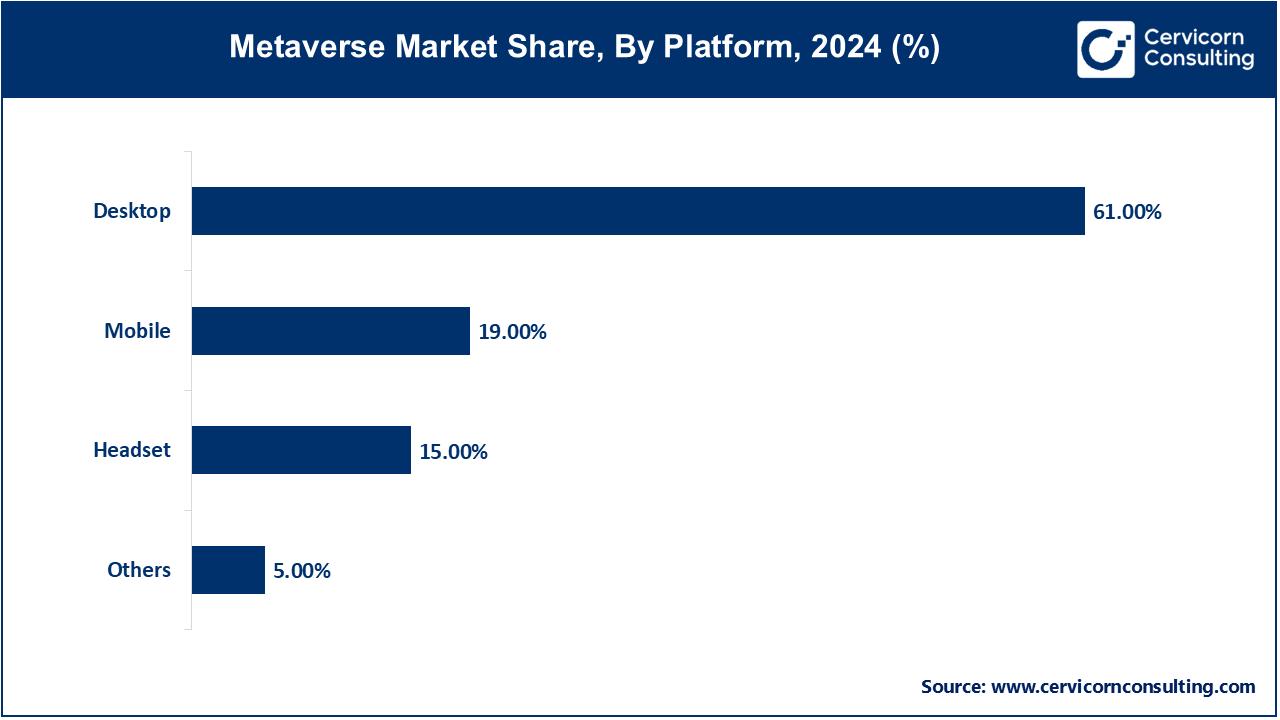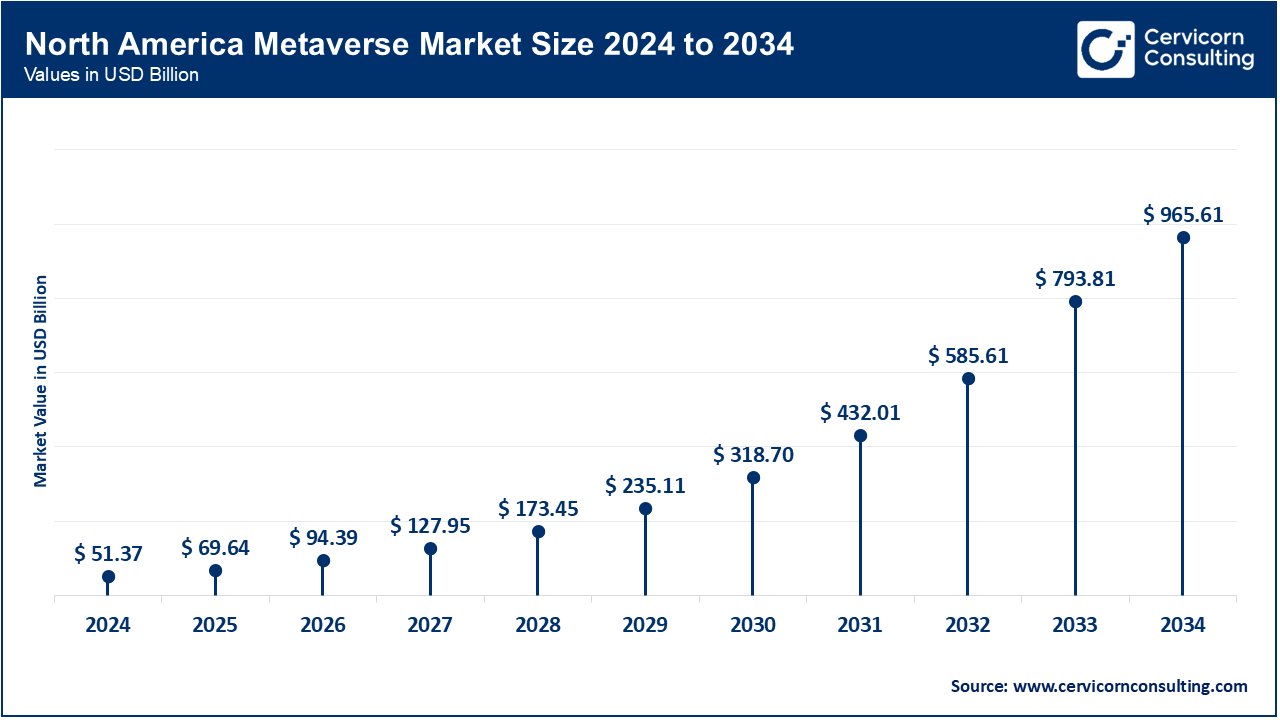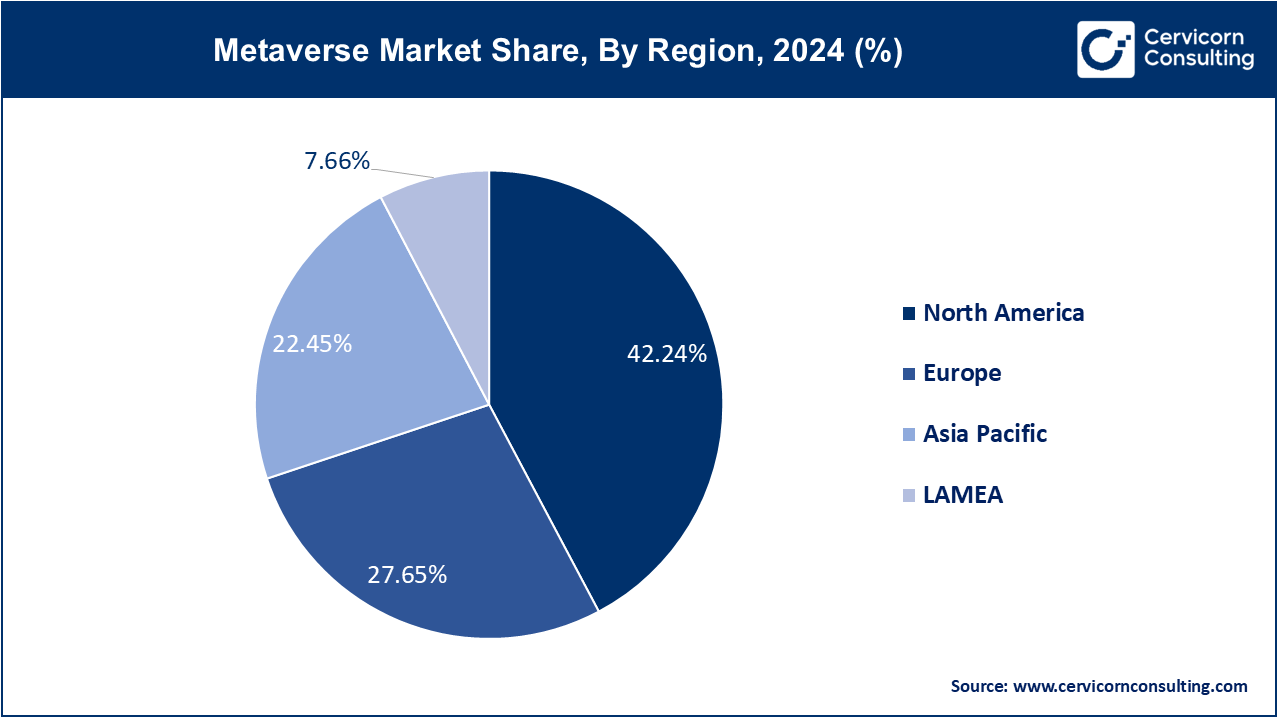The global metaverse market size was reported at USD 121.62 billion in 2024 and is expected to reach around USD 2,286 billion by 2034, growing at a compound annual growth rate (CAGR) of 35.55% from 2025 to 2034.
The metaverse market has become a focal point for investment and innovation, attracting attention from both tech giants and new startups. With its ability to merge social interaction, entertainment, commerce, and work into a single immersive experience, the metaverse is shaping up to be a multi-faceted ecosystem. Companies across various industries are leveraging the metaverse's potential to create virtual storefronts, hold virtual events, and offer services in digital environments. For example, virtual real estate has become a growing market, with individuals and organizations purchasing land within platforms like Decentraland and The Sandbox for investment or development purposes. The gaming sector, one of the early adopters of the metaverse, continues to thrive within virtual worlds. Games like Fortnite and Roblox have already built massive virtual communities, offering opportunities for brands to advertise and users to interact in real-time. According to reports, in 2021, the virtual real estate market exceeded USD 500 million and is expected to grow even more with the expansion of the Metaverse.

The metaverse is a virtual, interconnected universe that blends physical and digital realities, allowing people to interact, socialize, and experience a variety of activities online through digital avatars. It is a 3D virtual space where users can explore, work, play, and engage in social interactions with others. The metaverse uses technologies like virtual reality (VR), augmented reality (AR), and blockchain to create immersive and interactive experiences. Users can buy, sell, and own virtual assets such as digital land, clothing for avatars, and even art. With metaverse platforms like Decentraland, Roblox, and Facebook’s Horizon Worlds, people can attend virtual events, collaborate on projects, and build communities all in a fully digital world.
Report Scope
| Area of Focus | Details |
| Market Size in 2025 | USD 164.86 Billion |
| Market Size by 2034 | USD 2,286 Billion |
| Market Growth Rate | CAGR of 35.55% from 2025 to 2034 |
| Largest Market | North America |
| Fastest Growing Market | Asia Pacific |
| Segment Coverage | By Technology, Platform, Product, Application, End User and Regions |
Increasing Popularity of Online Gaming:
Corporate and Brand Engagement:
Privacy and Security Concerns:
Digital Divide and Accessibility Issues:
Educational and Training Applications:
Real Estate and Urban Planning:
Regulatory and Legal Uncertainty:
User Experience and Interoperability:
Virtual Reality (VR): Virtual Reality (VR) creates fully immersive digital environments, allowing users to interact with 3D worlds using headsets and controllers. In the metaverse, VR enables realistic simulations for gaming, training, and social interactions. Current trends include the development of more affordable and lightweight VR hardware, enhanced graphics and sensory experiences, and VR's integration with social platforms to create more engaging and interactive virtual communities.
Augmented Reality (AR): Augmented Reality (AR) overlays digital content onto the physical world, enhancing real-world experiences through devices like smartphones and AR glasses. In the metaverse, AR facilitates interactive applications in retail, navigation, and gaming. Trends include advancements in AR hardware, such as smart glasses, improved spatial mapping for more accurate overlays, and AR's use in creating hybrid virtual-physical experiences that seamlessly blend both realities.
Mixed Reality (MR): Mixed Reality (MR) combines elements of both VR and AR, allowing users to interact with virtual objects in the real world in a dynamic, interactive manner. In the metaverse, MR enables applications in collaborative work environments, design, and training. Current trends focus on developing MR headsets with better spatial awareness, enhanced user interfaces, and more intuitive controls, fostering seamless integration between digital and physical interactions.
Blockchain: Blockchain technology underpins decentralized digital economies within the metaverse, providing secure and transparent transactions through smart contracts and NFTs. It ensures digital ownership and authenticity of virtual goods. Trends include the growing adoption of NFTs for digital art and collectibles, the development of decentralized metaverse platforms, and the integration of blockchain with AI to enhance virtual economies and user interactions.
Artificial Intelligence (AI): Artificial Intelligence (AI) powers intelligent systems and avatars in the metaverse, enabling personalized experiences and content generation. AI enhances interactions through natural language processing, adaptive learning, and behavioral modeling. Trends involve using AI for creating realistic virtual environments, dynamic storytelling, and automating complex processes within virtual worlds. AI also aids in developing smart assistants and enhancing the realism of user-generated content.
Internet of Things (IoT): The Internet of Things (IoT) connects physical devices to the digital metaverse, enabling real-time data exchange and interaction between virtual and physical worlds. IoT enhances metaverse experiences through smart devices, wearables, and sensors. Trends include the integration of IoT with AR and VR for immersive experiences, smart home and city applications within virtual environments, and using IoT data for personalized and context-aware virtual interactions.
Desktop: Desktop platforms are traditional computing systems that provide access to metaverse environments via PCs and laptops. They offer high processing power and graphics capabilities for immersive experiences. Desktop platforms are leveraging advancements in graphics processing and internet connectivity to enhance virtual worlds. The desktop segment has reported highest market share of 61% in 2024. The rise of cloud gaming and web-based metaverse applications makes access more seamless and less dependent on high-end hardware, expanding user participation.

Mobile: Mobile platforms include smartphones and tablets, enabling users to access metaverse environments on-the-go through AR applications and mobile-based virtual worlds. With the proliferation of 5G networks, mobile platforms are becoming increasingly central to the metaverse experience, offering smoother, more responsive interactions. Mobile AR apps, like Pokémon GO, are paving the way for new location-based and social experiences, driving user engagement and monetization opportunities. This segment has generated market share of 19% in 2024.
Headsets: Headsets refer to VR and AR devices, such as Oculus Rift and HoloLens, providing immersive experiences by immersing users in virtual environments or overlaying digital elements on the physical world. Headsets are becoming more affordable and technologically advanced, with improvements in resolution, comfort, and wireless capabilities. This segment has considered market share of 15% in 2024. The development of standalone devices and enhanced tracking technologies is making VR and AR more accessible, driving wider adoption in gaming, education, and enterprise applications.
Others: This category includes emerging platforms like smart TVs, gaming consoles, and wearables, offering alternative entry points into the metaverse. Gaming consoles are integrating more VR and AR capabilities, while wearables like smart glasses offer new ways to interact with digital content. The others segment has measured market share of 5% in 2024. These platforms are exploring innovative use cases, such as virtual events and interactive content, broadening the scope of metaverse experiences and attracting diverse user demographics.
Gaming: In the metaverse, gaming involves immersive virtual worlds where players interact in real-time, often with expansive multiplayer experiences. Trends include integration of VR and AR technologies, blockchain-based in-game economies, and user-generated content. The rise of esports and virtual reality gaming platforms is driving innovation and expanding user engagement, making gaming a central component of the metaverse ecosystem.
Online Shopping: Online shopping in the metaverse creates virtual storefronts where users can browse and purchase digital and physical goods. Trends include virtual try-ons, interactive product displays, and integration with digital currencies and NFTs. This segment is growing as brands and retailers leverage immersive experiences to enhance customer engagement, personalize shopping, and streamline the purchasing process.
Content Creation & social media: Content creation and social media in the metaverse involve developing and sharing virtual experiences, digital art, and interactive media. Trends include the use of AR and VR tools for creating immersive content, virtual influencers, and new forms of social interaction. This segment is expanding as creators and users explore innovative ways to connect, share, and engage within virtual environments.
Events & Conferences: Events and conferences in the metaverse offer virtual venues for hosting meetings, seminars, and gatherings. Trends include interactive virtual event platforms, real-time networking, and digital event spaces that mimic physical experiences. The ability to host large-scale, global events without geographic constraints is driving growth, as organizations seek more engaging and accessible ways to connect with audiences.
Digital Marketing (Advertising): In digital marketing, the metaverse provides immersive advertising opportunities through virtual billboards, branded virtual spaces, and interactive campaigns. Trends include personalized and contextually relevant ads, integration with AR/VR experiences, and the use of NFTs for exclusive promotions. This segment is growing as brands seek innovative ways to reach and engage consumers in virtual environments.
Testing & Inspection: Testing and inspection in the metaverse involve using virtual environments for product and process evaluations. Trends include virtual simulations for quality assurance, digital twins for real-time monitoring, and remote inspections using AR tools. This segment is expanding as industries leverage the metaverse to improve accuracy, reduce costs, and streamline testing and inspection procedures.
Others: The "Others" segment in the metaverse encompasses various niche applications, such as virtual tourism, real estate, and health simulations. Trends include virtual travel experiences, digital real estate markets, and immersive health and wellness programs. This segment reflects the metaverse's versatility and its potential to transform diverse aspects of daily life and industry practices.
In North America, the metaverse market is driven by significant investment from tech giants and startups, leading to rapid innovation and adoption. North America market size is expected to reach around USD 965.61 billion by 2034 increasing from USD 51.37 billion in 2024 with a CAGR of 35.89%. Trends include the integration of metaverse technologies in entertainment and gaming, with major players like Meta and Microsoft pioneering advanced VR and AR experiences. Additionally, North America is a leader in developing metaverse applications for business, including virtual workplaces and remote collaboration tools.

The Asia-Pacific region is experiencing rapid growth in the metaverse market due to high digital adoption and technological advancements. Asia Pacific market size is calculated at USD 27.30 billion in 2024 and is projected to grow around USD 513.21 billion by 2034 with a CAGR of 39.21%. Trends include the rise of virtual social platforms and gaming environments, particularly in countries like China, Japan, and South Korea. Additionally, there is significant interest in integrating metaverse technologies with e-commerce and digital payments, supported by robust infrastructure and a large consumer base.
Europe's metaverse market is characterized by a strong focus on regulatory frameworks and data privacy. Europe market size is measured at USD 33.63 billion in 2024 and is expected to grow around USD 632.08 billion by 2034 with a CAGR of 36.4%. Trends include the development of sustainable and ethical metaverse solutions, driven by the EU's strict regulations on data protection and digital rights. European countries are also exploring the metaverse for cultural and educational purposes, with initiatives aimed at enhancing virtual museums, art galleries, and educational platforms.

In LAMEA (Latin America, Middle East, and Africa), the metaverse market is emerging with a focus on accessibility and localized content. LAMEA market size is forecasted to reach around USD 175.11 billion by 2034 from USD 9.32 billion in 2024 with a CAGR of 29.1%. Trends include the development of virtual environments tailored to regional cultures and languages, as well as the use of the metaverse for educational and community engagement purposes. In the Middle East and Africa, there is growing interest in leveraging the metaverse for business applications and digital infrastructure development, aiming to overcome connectivity and resource challenges.
New players like Somnium Space and The Sandbox are driving innovation in the metaverse with unique virtual worlds and decentralized platforms. They focus on user-generated content and virtual real estate, providing novel experiences and ownership models. Dominating the market, Meta Platforms and Microsoft lead with their expansive VR and AR ecosystems, integrating metaverse technologies into social media, gaming, and business solutions. NVIDIA supports these developments with powerful GPUs, while Epic Games and Unity Technologies provide essential tools for creating immersive environments and experiences.
Market Segmentation
By Technology
By Platform
By Product
By Application
By End User
By Regions
Chapter 1 Market Introduction and Overview
1.1 Market Definition and Scope
1.1.1 Overview of Metaverse
1.1.2 Scope of the Study
1.1.3 Research Timeframe
1.2 Research Methodology and Approach
1.2.1 Methodology Overview
1.2.2 Data Sources and Validation
1.2.3 Key Assumptions and Limitations
Chapter 2 Executive Summary
2.1 Market Highlights and Snapshot
2.2 Key Insights by Segments
2.2.1 By Technology Overview
2.2.2 By Platform Overview
2.2.3 By Product Overview
2.2.4 By Application Overview
2.2.5 By End User Overview
2.3 Competitive Overview
Chapter 3 Global Impact Analysis
3.1 COVID 19 Impact on Metaverse Market
3.1.1 COVID-19 Landscape: Pre and Post COVID Analysis
3.1.2 COVID 19 Impact: Global Major Government Policy
3.1.3 Market Trends and Opportunities in the COVID-19 Landscape
3.2 Russia-Ukraine Conflict: Global Market Implications
3.3 Regulatory and Policy Changes Impacting Global Markets
Chapter 4 Market Dynamics and Trends
4.1 Market Dynamics
4.1.1 Market Drivers
4.1.1.1 Increasing Popularity of Online Gaming
4.1.1.2 Corporate and Brand EngTechnologyment
4.1.2 Market Restraints
4.1.2.1 Privacy and Security Concerns
4.1.2.2 Digital Divide and Accessibility Issues
4.1.3 Market Opportunity
4.1.3.1 Educational and Training Applications
4.1.3.2 Real Estate and Urban Planning
4.1.4 Market Challenges
4.1.4.1 Regulatory and Legal Uncertainty
4.1.4.2 User Experience and Interoperability
4.2 Market Trends
Chapter 5 Premium Insights and Analysis
5.1 Global Metaverse Market Dynamics, Impact Analysis
5.2 Porter’s Five Forces Analysis
5.2.1 Bargaining Power of Suppliers
5.2.2 Bargaining Power of Buyers
5.2.3 Threat of Substitute Products
5.2.4 Rivalry among Existing Firms
5.2.5 Threat of New Entrants
5.3 PESTEL Analysis
5.4 Value Chain Analysis
5.5 Product Pricing Analysis
5.6 Vendor Landscape
5.6.1 List of Buyers
5.6.2 List of Suppliers
Chapter 6 Metaverse Market, By Technology
6.1 Global Metaverse Market Snapshot, By Technology
6.1.1 Market Revenue (($Billion) and Growth Rate (%), 2022-2034
6.1.1.1 Virtual Reality (VR)
6.1.1.2 Augmented Reality (AR)
6.1.1.3 Mixed Reality (MR)
6.1.1.4 Blockchain
6.1.1.5 Artificial Intelligence (AI)
6.1.1.6 Internet of Things (IoT)
Chapter 7 Metaverse Market, By Platform
7.1 Global Metaverse Market Snapshot, By Platform
7.1.1 Market Revenue (($Billion) and Growth Rate (%), 2022-2034
7.1.1.1 Desktop
7.1.1.2 Mobile
7.1.1.3 Headsets
7.1.1.4 Others
Chapter 8 Metaverse Market, By Product
8.1 Global Metaverse Market Snapshot, By Product
8.1.1 Market Revenue (($Billion) and Growth Rate (%), 2022-2034
8.1.1.1 Infrastructure
8.1.1.2 Hardware
8.1.1.3 Software
8.1.1.4 Services
Chapter 9 Metaverse Market, By Application
9.1 Global Metaverse Market Snapshot, By Application
9.1.1 Market Revenue (($Billion) and Growth Rate (%), 2022-2034
9.1.1.1 Gaming
9.1.1.2 Online Shopping
9.1.1.3 Content Creation & Social Media
9.1.1.4 Events & Conference
9.1.1.5 Digital Marketing (Advertising)
9.1.1.6 Testing & Inspection
9.1.1.7 Others
Chapter 10 Metaverse Market, By End User
10.1 Global Metaverse Market Snapshot, By End User
10.1.1 Market Revenue (($Billion) and Growth Rate (%), 2022-2034
10.1.1.1 Aerospace & Defense
10.1.1.2 Education
10.1.1.3 Healthcare
10.1.1.4 Tourism & Hospitality
10.1.1.5 Retail
10.1.1.6 Media & Entertainment
10.1.1.7 Automotive
10.1.1.8 Others
Chapter 11 Metaverse Market, By Region
11.1 Overview
11.2 Metaverse Market Revenue Share, By Region 2024 (%)
11.3 Global Metaverse Market, By Region
11.3.1 Market Size and Forecast
11.4 North America
11.4.1 North America Metaverse Market Revenue, 2022-2034 ($Billion)
11.4.2 Market Size and Forecast
11.4.3 North America Metaverse Market, By Country
11.4.4 U.S.
11.4.4.1 U.S. Metaverse Market Revenue, 2022-2034 ($Billion)
11.4.4.2 Market Size and Forecast
11.4.4.3 U.S. Market Segmental Analysis
11.4.5 Canada
11.4.5.1 Canada Metaverse Market Revenue, 2022-2034 ($Billion)
11.4.5.2 Market Size and Forecast
11.4.5.3 Canada Market Segmental Analysis
11.4.6 Mexico
11.4.6.1 Mexico Metaverse Market Revenue, 2022-2034 ($Billion)
11.4.6.2 Market Size and Forecast
11.4.6.3 Mexico Market Segmental Analysis
11.5 Europe
11.5.1 Europe Metaverse Market Revenue, 2022-2034 ($Billion)
11.5.2 Market Size and Forecast
11.5.3 Europe Metaverse Market, By Country
11.5.4 UK
11.5.4.1 UK Metaverse Market Revenue, 2022-2034 ($Billion)
11.5.4.2 Market Size and Forecast
11.5.4.3 UK Market Segmental Analysis
11.5.5 France
11.5.5.1 France Metaverse Market Revenue, 2022-2034 ($Billion)
11.5.5.2 Market Size and Forecast
11.5.5.3 France Market Segmental Analysis
11.5.6 Germany
11.5.6.1 Germany Metaverse Market Revenue, 2022-2034 ($Billion)
11.5.6.2 Market Size and Forecast
11.5.6.3 Germany Market Segmental Analysis
11.5.7 Rest of Europe
11.5.7.1 Rest of Europe Metaverse Market Revenue, 2022-2034 ($Billion)
11.5.7.2 Market Size and Forecast
11.5.7.3 Rest of Europe Market Segmental Analysis
11.6 Asia Pacific
11.6.1 Asia Pacific Metaverse Market Revenue, 2022-2034 ($Billion)
11.6.2 Market Size and Forecast
11.6.3 Asia Pacific Metaverse Market, By Country
11.6.4 China
11.6.4.1 China Metaverse Market Revenue, 2022-2034 ($Billion)
11.6.4.2 Market Size and Forecast
11.6.4.3 China Market Segmental Analysis
11.6.5 Japan
11.6.5.1 Japan Metaverse Market Revenue, 2022-2034 ($Billion)
11.6.5.2 Market Size and Forecast
11.6.5.3 Japan Market Segmental Analysis
11.6.6 India
11.6.6.1 India Metaverse Market Revenue, 2022-2034 ($Billion)
11.6.6.2 Market Size and Forecast
11.6.6.3 India Market Segmental Analysis
11.6.7 Australia
11.6.7.1 Australia Metaverse Market Revenue, 2022-2034 ($Billion)
11.6.7.2 Market Size and Forecast
11.6.7.3 Australia Market Segmental Analysis
11.6.8 Rest of Asia Pacific
11.6.8.1 Rest of Asia Pacific Metaverse Market Revenue, 2022-2034 ($Billion)
11.6.8.2 Market Size and Forecast
11.6.8.3 Rest of Asia Pacific Market Segmental Analysis
11.7 LAMEA
11.7.1 LAMEA Metaverse Market Revenue, 2022-2034 ($Billion)
11.7.2 Market Size and Forecast
11.7.3 LAMEA Metaverse Market, By Country
11.7.4 GCC
11.7.4.1 GCC Metaverse Market Revenue, 2022-2034 ($Billion)
11.7.4.2 Market Size and Forecast
11.7.4.3 GCC Market Segmental Analysis
11.7.5 Africa
11.7.5.1 Africa Metaverse Market Revenue, 2022-2034 ($Billion)
11.7.5.2 Market Size and Forecast
11.7.5.3 Africa Market Segmental Analysis
11.7.6 Brazil
11.7.6.1 Brazil Metaverse Market Revenue, 2022-2034 ($Billion)
11.7.6.2 Market Size and Forecast
11.7.6.3 Brazil Market Segmental Analysis
11.7.7 Rest of LAMEA
11.7.7.1 Rest of LAMEA Metaverse Market Revenue, 2022-2034 ($Billion)
11.7.7.2 Market Size and Forecast
11.7.7.3 Rest of LAMEA Market Segmental Analysis
Chapter 12 Competitive Landscape
12.1 Competitor Strategic Analysis
12.1.1 Top Player Positioning/Market Share Analysis
12.1.2 Top Winning Strategies, By Company, 2022-2024
12.1.3 Competitive Analysis By Revenue, 2022-2024
12.2 Recent Developments by the Market Contributors (2024)
Chapter 13 Company Profiles
13.1 Meta Platforms, Inc. (formerly Facebook, Inc.)
13.1.1 Company Snapshot
13.1.2 Company and Business Overview
13.1.3 Financial KPIs
13.1.4 Product/Service Portfolio
13.1.5 Strategic Growth
13.1.6 Global Footprints
13.1.7 Recent Development
13.1.8 SWOT Analysis
13.2 Microsoft Corporation
13.3 Google LLC
13.4 NVIDIA Corporation
13.5 Epic Games, Inc.
13.6 Roblox Corporation
13.7 Unity Technologies, Inc.
13.8 Tencent Holdings Limited
13.9 Alibaba Group Holding Limited
13.10 Decentraland Foundation